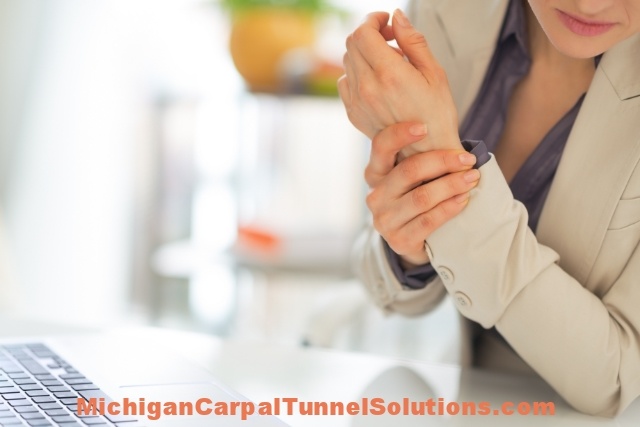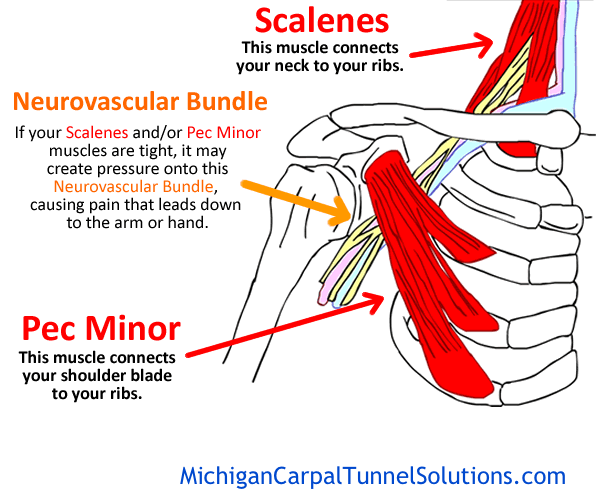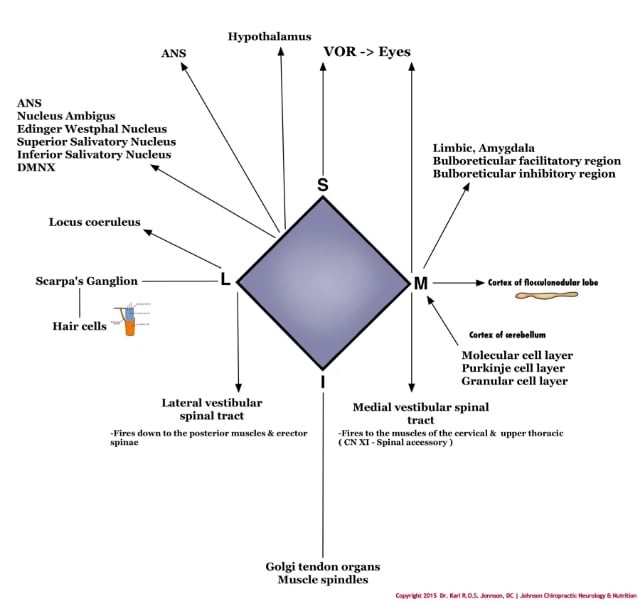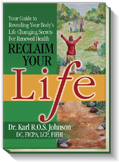 The standard medical definition of carpal tunnel syndrome (CTS) goes something like this: "Carpal tunnel syndrome is a hand and arm condition that causes numbness, tingling and other symptoms. Carpal tunnel syndrome is caused by a pinched nerve in your wrist." [1] While the official definition states it is due to a pinched nerve in your wrist, I have found the condition to be more involved. If the proper additional areas of involvement are not addressed, you could end up having wrist focused treatment and not get your CTS resolved. You likely will need a more comprehensive approach such as I outline in this article. It's prudent to first describe the main symptoms that those with CTS often agonize with.
The standard medical definition of carpal tunnel syndrome (CTS) goes something like this: "Carpal tunnel syndrome is a hand and arm condition that causes numbness, tingling and other symptoms. Carpal tunnel syndrome is caused by a pinched nerve in your wrist." [1] While the official definition states it is due to a pinched nerve in your wrist, I have found the condition to be more involved. If the proper additional areas of involvement are not addressed, you could end up having wrist focused treatment and not get your CTS resolved. You likely will need a more comprehensive approach such as I outline in this article. It's prudent to first describe the main symptoms that those with CTS often agonize with.
The symptoms of carpal tunnel syndrome can be quite painful and annoying to say the least. Below is a list of some of the symptoms that mild CTS sufferers experience:
- Numbness or pain in your hand, forearm, or wrist that awakens you at night. (Shaking or moving your fingers may ease this numbness and pain.)
- Occasional tingling, numbness, "pins-and-needles" sensation, or pain. The feeling is similar to your hand "falling asleep."
- Numbness or pain that gets worse while you are using your hand or wrist. You are most likely to feel it when you grip an object with your hand or bend (flex) your wrist.
- Occasional aching pain in your forearm between your elbow and wrist.
- Stiffness in your fingers when you get up in the morning.
moderate to severe sufferers often experience the following:
- May have numbness or reduced strength and grip in your fingers, thumb, or hand. As as result of the weakness it may be hard to:
- Do simple hand movements, such as brushing your hair or holding a fork. You may accidentally drop objects.
- Pinch an object between your thumb and first finger. (This is called loss of pinch strength.)
- Use your thumb while doing simple tasks such as opening a jar or using a screwdriver. With long-term carpal tunnel syndrome, the thumb muscles can get smaller and weaker (atrophy).
Unfortunately, if you have severe true carpal tunnel syndrome (with significant pressure on the nerves that traverse under the ligaments in the wrist that make up the carpal tunnel), you may have to resort to surgery. However, people who have some of the very annoying CTS symptoms may not have carpal tunnel syndrome at all...or...may be able to receive non-surgical help. Let me explain how the symptoms of carpal tunnel syndrome can come from problems in your neck, chest muscles and forearm muscles and what can be done about it.
Recently I had a retired female patient consult me about the severe hand and forearm pain that was waking her up at night. I performed my detailed case history review assessment, orthopedic, spinal, neurological and Trigenics®* examination. Thankfully I was able to tell this patient she didn't have carpal tunnel syndrome after all, and that I could help her with a multi-modal non-surgical approach.This particular patient retired from a job that required her to perform a tremendous amount of typing during the years of her employment. She had developed a pattern of muscle and joint dysfunction that created pressure on the nerves that eminate from the neck and end in the hands and fingers. The areas of nerve pressure occured in five distinct places:
- Her neck from disc and joint degeneration
- Where the nerves traverse under the collar bone and above the first rib
- Under the pectoralis minor chest muscle tendons, where they attach to a portion of the front of the shoulder blade
- Where the nerves enter the forearm
- Under the band of ligaments that form the front aspect of the carpal tunnel in the wrist
As a result of the nerve pressure she suffered with a pain syndrome that she thought was carpal tunnel syndome. Luckily for her, I found is was not CTS and that she could benefit from a non-surgical approach that would correct her problem.
The photo above shows two of the points where the nerve bundle known as the brachial plexus can be "pinched", leading to hand, wrist, arm or finger pain. In the case of my patient, she had several other locations of nerve pressure as well. Since she had so many of these areas of nerve pressure, I develoloped a treatment plan to deal with all of them and assist her body in healing quickly.
Using a root cause approach, rather than focusing only on the pain is the key to lasting results.
One very important, but difficult concept to explain, is called dysafferentation. This word simply means that input of normal sensation to the brain from joint, muscle and ligament structures is diminished, and as a result, the output from the brain to various structures (including muscles and organs) is negatively altered. Dysafferentation is a major cause of unrelenting pain and is hard-wired into our system. Our brain operates like a computer in that it requires accurate input to produce an appropriate output. Common lingo you may have heard or seen is the acronym GIGO (garbage in, garbage out). According to Wikipedia, "Garbage in, garbage out (GIGO) in the field of computer science or information and communications technology refers to the fact that computers, since they operate by logical processes, will unquestioningly process unintended, even nonsensical, input data ("garbage in") and produce undesired, often nonsensical, output ("garbage out"). The principle applies to other fields as well." [2]
Surprising for many people to hear is the fact that joint and muscle dsysfunction can alter blood pressure, heart rate, respiration and digestion. This diagram shows the connections that contribute to the malfunction in the body. Unless you are into neurology I know you won't get much out of looking at the diagram, but I wanted you to know that the mechansisms for structural dysfunction in the body affect us in many ways and is well documenTed, but not promoted by the medical mainstream. My job as a doctor and edcucator is to help you understand how the body works so you can take care of yours adequately.
Our bodies operate similarly to a computer in that the brain's output is dependant on what information is received from the body.
Dysafferentation has three specific attributes:
- Pain
- Loss of sensation
- Muscle weakness or cramping
By performing a thorough neurological examination, I determined the areas of sensation loss. My Trigenics® evaluation enabled me to map which muscles were weak and which were too tight. Once I discovered the areas of involvment, I developed a multi-modal treatment program aimed at helping improve the function of all the areas that were "misbehaving"
Based on my findings, the most important method to help this patient was determined to be the use of Trigenics® Myoneural Therapy. Every muscle that had the potential to compress the nerves that travel to the arms and hand were "reprogrammed" with the Trigenics® lengthening procedure, so they could assume their normal length again.
-
Trigenics® Myoneural Therapy. Trigenics® is so effective because it combines three treatment techniques together simultaneously to get a cumulative effect that you would not get performing one at a time. It uses resisted exercise neurology to help reboot your brain to body communication, along with concentrative biofeedback breathing to allow the body to accept the changes and lastly it uses muscle sensor manipulation which opens the door for the rebooting process to occur. The three together combine to create a “software update”. Physical, chemical and emotional stresses can corrupt our software and create imbalances in the way the brain talks to the body. While most people work on the body, we work on the brain for results that are both immediate and sustainable.
In order to help with the nerve root compression and the degeneration found in the patients' cervical spine (neck), I utilized the benefits of non-surgical spinal decompression.
- Triton DTS Non-Surgical Spinal Decompression. Non-Surgical Spinal Decompression is a revolutionary new technology used primarily to treat disc injuries in the neck and in the low back. This treatment option is very safe and utilizes FDA cleared equipment to apply distraction forces to spinal structures in a precise and graduated manner. Distraction is offset by cycles of partial relaxation. This technique of spinal decompression therapy (unloading compressed vertebral segments using distraction and positioning), has shown the ability to gently separate the vertebrae from each other, creating a vacuum inside the discs that we are targeting. This "vacuum effect" is also known as negative intra-discal pressure.
The negative pressure may induce the retraction of the herniated or bulging disc back into the inside of the disc, and off the nerve root, the thecal sac (the dual layered "scuba suit" the spinal cord lives in), or both. It happens only microscopically each time, but cumulatively, over four to six weeks, the results are quite dramatic.
The cycles of decompression and partial relaxation, over a series of visits, promote the diffusion of water, oxygen, and nutrient-rich fluids from the outside of the discs to the inside. These nutrients enable the torn and degenerated disc fibers to begin to heal.
To reduce pain, swelling and improve the speed of soft tissue and nerve healing I employed the following two therapies.
-
Cutting Edge MLS M6 Robotic LASER. The MLS laser is a Class IV laser capable of producing the energy needed to achieve a therapeutic dose of laser energy for superficial as well as deep tissues. In addition, it also has a patented technology called "Multi-wave Lock System" which enables less scatter for deep tissue treatment. The M6 Robotic MLS Laser also helps minimize human error by robotically applying the individualized correct therapeutic dosage needed for each patient. During Laser Therapy the infrared laser light interacts with tissues at the cellular level and metabolic activity increases within the cell, improving the transport of nutrients across the cell membrane. This initiates the production of cellular energy (ATP) that leads to a cascade of beneficial effects, increasing cellular function and health. Laser Therapy is proven to biostimulate tissue repair and growth. The Laser accelerates the healing process and decreases inflammation, pain and scar tissue formation. In the management of chronic pain, Class IV Laser Therapy can provide dramatic results. There are studies that show that laser helps cartilage to regenerate [3], [4], [5], as well as nerves to heal [6].
-
Pulsed Electromagnetic Field Therapy (PEMF). PEMF is an electro-magnetic field applied to a painful or dysfunctional area of the body. What makes this therapy so powerful is two things: the strength of the magnetic field generated by the machine; and the pulsating of the field around the part of the body that is not functioning properly. PEMF works by re-energizing damaged cells via inducement of electrical changes within the cell that restore it to its normal healthy state. It improves the ability of the membrane of the cell to allow the oxygen, water and nutrients it needs into the cell…and allows the metabolic wastes to exit the cell in a normal manner. The pulsing action of the PEMF literally “exercises” the cells that are exposed to the magnetic field and allows them to normalize. There are also studies that show that PEMF helps cartilage to regenerate [7], [8], and peripheral nerves to heal [9]
Another method I employed was the use of the Cox Flextion-Distraction method of chiropractic adjustment. Well researched; flexion distraction drops intradiscal pressures as low as -192mmHg and widens the spinal canal area by as much as 28%. As a bonus, flexion distraction returns motion to the spinal joints, too! I also performed specific extremity adjusting protocols for wrist dysfunction.
-
Specific joint manipulation to reduce of eliminate loss of joint play. [10] There are three movements within a joint: active, passive, and joint play. A well-esteemed medical researcher and clinician by the name of Dr. John Mennell taught the importance of proper joint function, particularly joint play, and how it relates to proper joint function, According to Dr. John Mennell's research, joint play occurs within the paraphysiological space (the last bit of normal movement beyond passive movement) within a joint. Joint play is the small amount of normal motion a joint needs to have in order to move without triggering pain nerves to fire. Without this normal joint play, nutrients cannot be exchanged, thus, degeneration occurs. According to Dr. Mennell, "Voluntary movements cannot be achieved unless certain well-defined movements of joint play are present. Movements of joint play are independent of the action of voluntary muscles. These joint play movements are very small but precise in range; it is upon their integrity that the easy, painless performance of movements in the voluntary range depends. Their integrity, not their range, is the basis of their importance. It is the summation of movements of joint play and movement in the voluntary range that make up the movement of the living anatomy."[11] The following are a few basic truths about joint play from Dr. Mennell's work:
- When a joint is not free to move, the muscles that move it are not free to move.
- Muscles cannot be restored to normal if the joint which they move is not free to move.
- Normal muscle function is dependent on normal joint movement.
- Impaired muscle function perpetuates and may cause deterioration in abnormal joints.
"The primary fault usually lies in synovial joints which make up joint play. And if the primary fault can be corrected, the secondary abnormalities resulting from it can usually be readily corrected too."[12]
In just two weeks using the multi-modal methods described above, I was able to eliminate this particular patient's pain to the point THAT she can sleep without pain waking her!
Each person's case is unique and deserves a detailed evaluation of the underlying causes of the pain of carpal tunnel syndrome, or chronic wrist, hand or forearm pain. I love helping people that other healthcare practitioners have given up on. It's a passion of mine. Not everyone that comes to my office can be accepted for care. I have a careful vetting process to be sure those I do accept will be the most likely to receive excellent clinical results. My motto is "If I don't think I can make a magnificant impact on your life, I won't accept you for care."
Hopefully, you can now understand why I am so excited about the process I use to help patients with hand, wrist and forearm pain achieve resolution to their pain without resorting to surgery. Perhaps you too can benefit from my clinically proven and research validated methods.
Don't keep this information a secret. Tell your friends and family that there is a solid non-surgical answer for carpal tunnel syndrome, chronic hand, wrist and forearm pain. Send them to www.MichiganCarpalTunnelSolutions.com today.
Always remember one of my mantras., "The more you know about how your body works, the better you can take care of yourself."
For more details about the natural approach I take with my patients, take a look at the book I wrote entitled: Reclaim Your Life; Your Guide To Revealing Your Body's Life-Changing Secrets For Renewed Health. It is available in my office or at Amazon and many other book outlets. If you found value in this article, please use the social sharing icons at the top of this post and please share with those you know who are still suffering with chronic health challenges, despite receiving medical management. Help me reach more people so they may regain their zest for living! Thank you!
ALL THE BEST – DR. KARL R.O.S. JOHNSON, DC – DIGGING DEEPER TO FIND SOLUTIONS
References:
1. http://www.mayoclinic.org/diseases-conditions/carpal-tunnel-syndrome/basics/definition/con-20030332
2. https://en.wikipedia.org/wiki/Garbage_in,_garbage_out
3. http://www.ncbi.nlm.nih.gov/pubmed/15523898
4. http://www.degruyter.com/view/j/plm.2014.3.issue-3/plm-2013-0063/plm-2013-0063.xml
5. http://link.springer.com/article/10.1007%2FBF02763980
6. http://www.ncbi.nlm.nih.gov/pmc/articles/PMC3065857/
7. http://www.ncbi.nlm.nih.gov/pmc/articles/PMC3014486/
8. http://www.ncbi.nlm.nih.gov/pubmed/24501089
9. http://www.ncbi.nlm.nih.gov/pubmed/6695016
10. http://www.ncbi.nlm.nih.gov/pmc/articles/PMC2565620/
11. Mennell, John. Joint Pain, Little Brown and Company, 1983
12. IBID
*The trademark Trigenics® is owned by the International Institute of Trigenics® Inc. Johnson Chiropractic Neurology & Nutrition is a licensee of the trademark.






